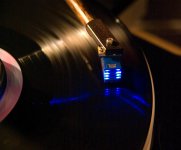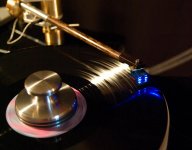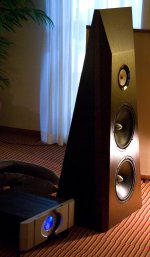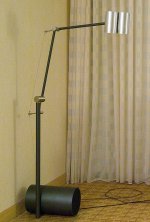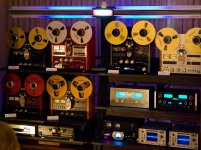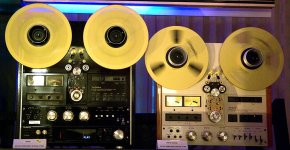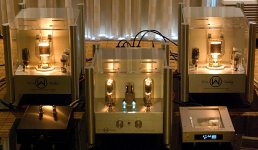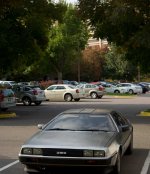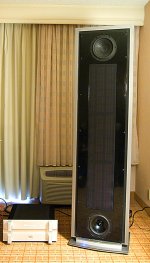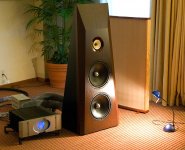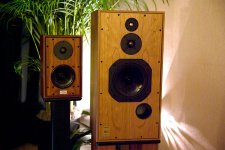Here are some glamor shots I took at the 2009 Rocky Mountain Audio Festival. I don't like flash, so I used RAW mode on the Pentax K10D and adjusted the 2250~2450 Kelvin tungsten lighting to a slightly warm balance - this is my approximation of how things looked visually to the show-goer when you visited the room.
First pix, a close-up of the SoundSmith strain-gauge cartridge in action, mounted on a Schroeder arm (these were very popular) and a VPI turntable.
First pix, a close-up of the SoundSmith strain-gauge cartridge in action, mounted on a Schroeder arm (these were very popular) and a VPI turntable.
Attachments
This was one of the best-sounding systems at the show, using the Feastex as a midrange/tweeter from 200 Hz on up, and a pair of AESpeakers 15" drivers below that. Digitally equalized, but an excellent implementation without the usual digital harshness. There was also a small rear tweeter, which looked like a 3/4" Vifa or Scan-Speak soft dome.
Attachments
This was one of the best-sounding systems at the show, using the Feastex as a midrange/tweeter from 200 Hz on up, and a pair of AESpeakers 15" drivers below that. Digitally equalized, but an excellent implementation without the usual digital harshness. There was also a small rear tweeter, which looked like a 3/4" Vifa or Scan-Speak soft dome.
Open back?
Sheldon
Well, that's my fourth try uploading a photo, and the server just stalls out and never completes the upload. I'll try again later - more photos to come.
Reply to Sheldon - yes, open back dipole for all drivers. Don't know how much EQ the system used, but they did disclose that the crossover was at 200 Hz. Subjectively, the system was quite flat, no obvious colorations jumped out at me. As you probably know, that is fairly rare at hifi shows, where most of the speakers have EQ problems.
Reply to Sheldon - yes, open back dipole for all drivers. Don't know how much EQ the system used, but they did disclose that the crossover was at 200 Hz. Subjectively, the system was quite flat, no obvious colorations jumped out at me. As you probably know, that is fairly rare at hifi shows, where most of the speakers have EQ problems.
Last edited:
Hi there, Planet10! By the way, who was the exhibitor? I don't remember - but the sound was good, definitely one of the better rooms at the show. As for woofer size, sure, 12" seems likely.
The RAAL omnidirectional speaker, using four small widerange drivers (two above, two below), and a single small RAAL ribbon nestled between the cylinders. Bass comes a pair of drivers in the floor-mounted cylinder. (Photo shows the Left speaker in the demo room.)
The system is bi-amplified, and the price includes equalizer, crossover, amplifiers, and speakers. I am sure I mis-heard Alexander when he said the whole thing would sell for US$4000.
The system is bi-amplified, and the price includes equalizer, crossover, amplifiers, and speakers. I am sure I mis-heard Alexander when he said the whole thing would sell for US$4000.
Attachments
Last edited:
This was one of the best-sounding systems at the show, ..
You know; I heard many speakers at the show and this one struck me in particular as not being one of the better ones. I guess different strokes for different folks.
The RAAL omnidirectional speaker, using four small widerange drivers (two above, two below), and a single small RAAL ribbon nestled between the cylinders. Bass comes a pair of drivers in the floor-mounted cylinder. (Photo shows the Left speaker in the demo room.)
The system is bi-amplified, and the price includes equalizer, crossover, amplifiers, and speakers. I am sure I mis-heard Alexander when he said the whole thing would sell for US$4000.
Lynn, one of us needs to get our ears checked. This one struck me as being hands down, easily, no contest, the worst sound at the show.
I guess if I am going to say that then I should say why. To my ears these speakers had no high end detail or definition. They sounded down right muffled and veiled. And they are supposed to be omnidirectional. But to me they had no sense of any type of imaging. Rather than an omni or spacious image, the image was seemed ill defined, unsettling and vague as if they were connected out of phase.
Last edited:
You know; I heard many speakers at the show and this one struck me in particular as not being one of the better ones. I guess different strokes for different folks.
One of the blights at the show was the dominance of server-based music, with no ability to listen to the CD or LP of your choice. This photo shows what happened some of the time - people trying to get the miserable computer to work, while the audience hears nothing but the annoying whirrr of the projector.
You could walk in a room and hear great sound, then awful sound with the next track, then silence as the exhibitor fooled around with the myriad settings on the computer - as shown below. After I took this picture, a third guy showed up to fiddle around with the computers.
The track-to-track variability of the server-based exhibitors - and RAAL was one of them - was dismaying. I wonder if there was a software-based 44.1 -> 48 kHz sample-rate conversion in there that the exhibitors didn't know about - or various other computer-based glitches that bit the unwary. Computer playback can range from the glorious heights of Keith Johnson-recorded 176/24 to the depths of MP3's that have been sample-rate-converted by Kmixer or the Apple equivalent.
You had to ask for high-res (176 or 192 kHz) sources - and most exhibitors didn't have them on the server, just an assortment of downloads from their favorite CD's. For all I know, they could have been playing MP3's. The rooms that sounded consistently good were playing LP's or analog tape. The digital sound was all over the place.
Attachments
Last edited:
Some of my favorite rooms, echoing the comments of "mor2bz" on the Loudspeakers forum. First, the Janszen room, with the unusual-looking hybrid electrostats (sorry about the motion blur, it was very dim inside this room).
Attachments
Last edited:
And another photo of the Feastrex/AESpeaker dipole speaker, this time more of a long-shot that gives a better sense of scale.
Usually, the digitally-equalized rooms were my least favorite, but this one had a smooth, silky sound with no sense of digital edge and grain. The Feastrex drivers also have the unusual property of not sounding like Fostex, Lowthers, or AERs, despite appearances. One of the few where the looks matched the sound.
Usually, the digitally-equalized rooms were my least favorite, but this one had a smooth, silky sound with no sense of digital edge and grain. The Feastrex drivers also have the unusual property of not sounding like Fostex, Lowthers, or AERs, despite appearances. One of the few where the looks matched the sound.
Attachments
Last edited:
The Harbeth room was enjoyable, too. The kind of balance I like, and very musical.
Attachments
Last edited:
Thanks for sharing the photos !
Very lucky you guys in the US have such event.
What are those "buldges" behind the feastrex dipoles? Are they cables???
Very lucky you guys in the US have such event.
What are those "buldges" behind the feastrex dipoles? Are they cables???
Last edited:
- Status
- Not open for further replies.
- Home
- Member Areas
- Clubs & Events
- RMAF 09 Photos
